BASIC PROPORTIONALITY THEOREM PROOF
Theorem :
If a straight line is drawn parallel to one side of a triangle intersecting the other two sides, then it divides the two sides in the same ratio.
Given : In a triangle ABC, a straight line l parallel to BC, intersects AB at D and AC at E.
To prove : AD/DB = AE/EC
Construction :
Join BE, CD.
Draw EF ⊥ AB and DG ⊥ CA
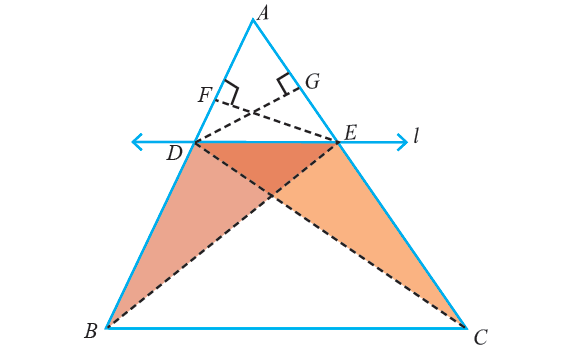
Proof :
Step 1 :
Because EF ⊥ AB, EF is the height of the triangles ADE and DBE.
Area (ΔADE) = 1/2 ⋅ base ⋅ height = 1/2 ⋅ AD ⋅ EF
Area (ΔDBE) = 1/2 ⋅ base ⋅ height = 1/2 ⋅ DB ⋅ EF
Therefore,
Area (ΔADE) / Area (ΔDBE) :
= (1/2 ⋅ AD ⋅ EF)/(1/2 ⋅ DB ⋅ EF)
Area (ΔADE)/Area (ΔDBE) = AD/DB ----(1)
Step 2 :
Similarly, we get
Area (ΔADE) / Area (ΔDCE) :
= (1/2 ⋅ AE ⋅ DG)/(1/2 ⋅ EC ⋅ DG)
Area (ΔADE)/Area (ΔDCE) = AE/EC ----(2)
Step 3 :
But ΔDBE and ΔDCE are on the same base DE and between the same parallel straight lines BC and DE.
Therefore,
Area (ΔDBE) = Area (ΔDCE) ----(3)
Step 4 :
From (1), (2) and (3), we can obtain
AD/DB = AE/EC
Hence, the theorem is proved.
Examples 1-2 : Find the missing length indicated.
Example 1 :
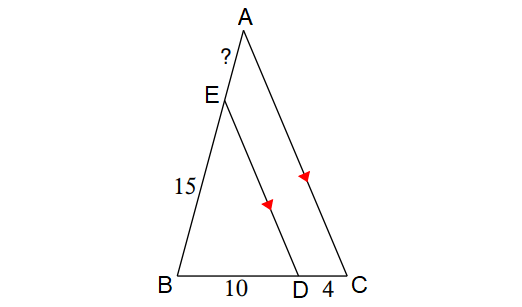
Solution :
In the triangle shown above, line segment ED is parallel to the side AC.
By Triangle Proportionality Theorem,
BE/EA = BD/DC
Substitute.
15/EA = 10/4
15/EA = 5/2
Take reciprocal on both sides.
EA/15 = 2/5
Multiply both sides by 15.
EA = 6
Example 2 :
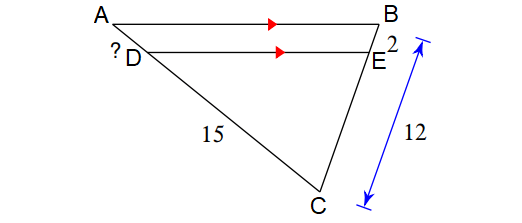
Solution :
In the triangle shown above, line segment ED is parallel to the side AB.
By Triangle Proportionality Theorem,
CD/DA = CE/EB
CD/DA = (CB - EB)/EB
Substitute.
15/DA = (12 - 2)/2
15/DA = 10/2
15/DA = 5
Take reciprocal on both sides.
DA/15 = 1/5
Multiply both sides by 15.
DA = 3
Example 3 :
Solve for x.
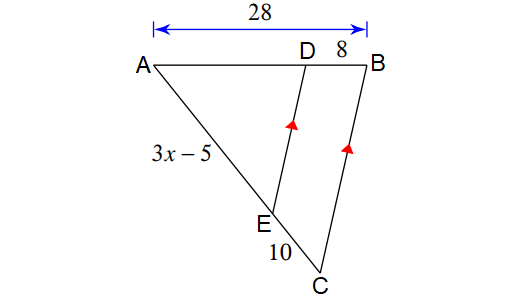
Solution :
In the triangle shown above, line segment ED is parallel to the side BC.
By Triangle Proportionality Theorem,
AD/DB = AE/EC
(AB - DB)/DB = AE/EC
Substitute.
(28 - 8)/8 = (3x - 5)/10
20/8 = (3x - 5)/10
5/2 = (3x - 5)/10
Multiply both sides by 10.
25 = 3x - 5
Add 5 to both sides.
30 = 3x
Divide both sides by 3.
10 = x
Example 4 :
Solve for x.
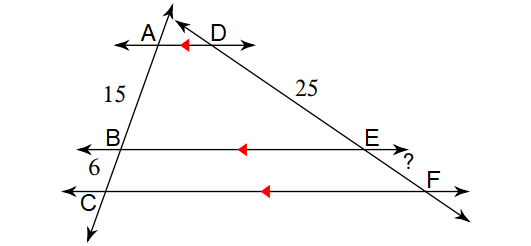
Solution :
In the diagram above, line segments AD, BE and CF are parallel to each other.
By Theorem,
AB/BC = DE/EF
Substitute.
15/6 = 25/EF
5/2 = 25/EF
Take reciprocal on both sides.
2/5 = EF/25
Multiply both sides by 25.
10 = EF
Example 5 :
Solve for x.
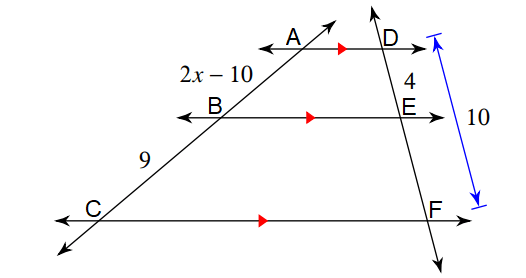
Solution :
In the diagram above, line segments AD, BE and CF are parallel to each other.
By Theorem,
AB/BC = DE/EF
AB/BC = DE/(DF - DE)
Substitute.
(2x - 10)/9 = 4/(10 - 4)
(2x - 10)/9 = 4/6
(2x - 10)/9 = 2/3
3(2x - 10) = 9(2)
6x - 30 = 18
Add 30 to both sides.
6x = 48
Divide both sides by 6.
x = 8
Kindly mail your feedback to v4formath@gmail.com
We always appreciate your feedback.
©All rights reserved. onlinemath4all.com
Recent Articles
-
Multi Step Algebra Word Problems
Apr 23, 24 09:10 PM
Multi Step Algebra Word Problems -
Solving Multi Step Word Problems Worksheet
Apr 23, 24 12:32 PM
Solving Multi Step Word Problems Worksheet -
Solving Multi Step Word Problems
Apr 23, 24 12:07 PM
Solving Multi Step Word Problems
